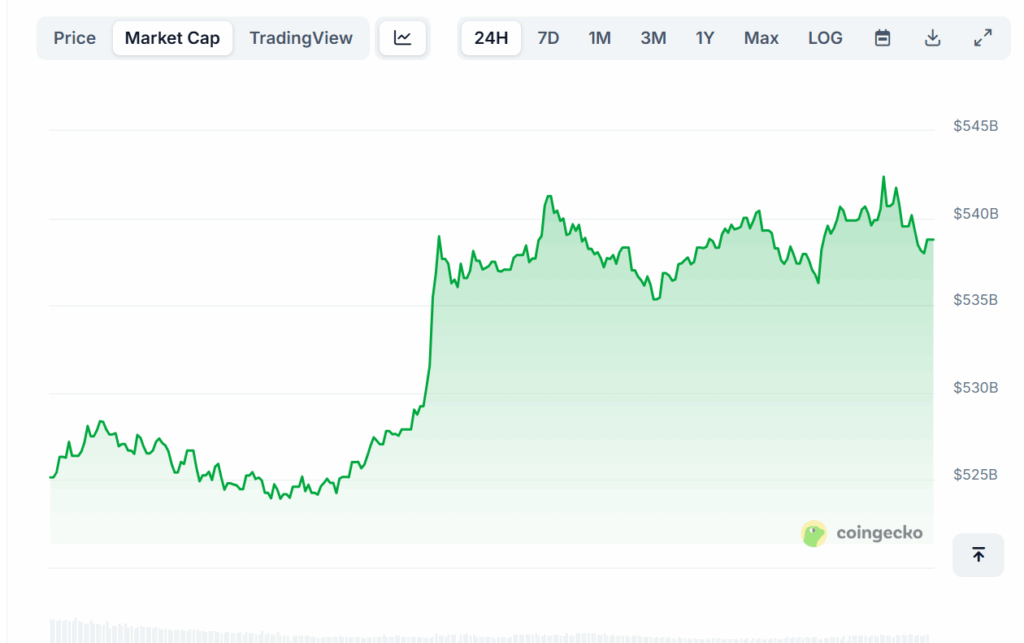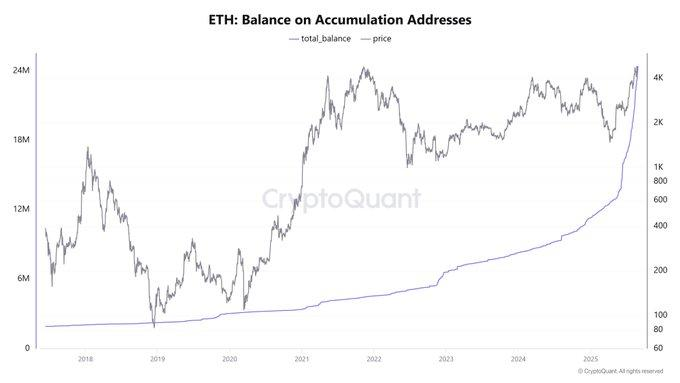Ethereum retests the $4,300 zone for the third time, backed by $8B of August demand and 24.3M ETH in accumulation wallets. This surge in net demand and reduced circulating supply strengthens support and increases the likelihood of sustained upside if whale buying continues.
-
Ethereum retests $4,300 zone with $8B August inflows, signaling stronger buyer conviction.
-
Accumulation wallets now hold 24.3M ETH, reducing active circulation and tightening supply.
-
ETH rose roughly 3.5x over four months while holding above $4,000, driven by concentrated whale buying.
Ethereum retest $4,300: $8B August demand and 24.3M ETH accumulation suggest stronger support — read concise analysis and next steps.
What is driving Ethereum’s retest of the $4,300 zone?
Ethereum is retesting the $4,300 zone as record August net demand (~1.5M ETH, ~$8B) and rising accumulation addresses (24.3M ETH) outpaced issuance, creating tighter effective supply and stronger price support in the short to medium term.
How strong is the current demand versus historical tests?
August 2025 saw roughly 1.5 million ETH purchased, worth about $8 billion, a level of demand not seen in previous $4,300 touches. Historical tests in 2021 led to exhaustion; this retest differs because accumulation addresses steadily increase holdings, according to CryptoQuant. Market-cap and volume data from Coingecko show active liquidity around the current price band.
Ethereum retests the $4,300 zone for the third time with $8B in August demand and 24.3M ETH accumulation supporting long-term strength.
- Ethereum retests $4,300 zone for the third time with $8B in August demand supporting strength.
- ETH accumulation wallets hold 24.3M coins, reducing circulation and boosting long-term support.
- Ethereum surged 3.5x in four months while holding above $4K, showing whale-driven market momentum.
Ethereum has returned to a rare trading zone that it has tested only three times in history. In 2021, this level marked exhaustion and price retracement. This time, Ethereum enters the range with record demand, as over 1.5 million ETH, worth $8 billion, were purchased in August alone.
Why does the $4,300 zone matter now?
The $4,300 to $4,400 band is a structural pivot. Current trading places Ethereum around $4,464 with a daily range near $4,340–$4,491. Market-cap and 24-hour volume data from Coingecko indicate deep liquidity, while accumulation metrics highlight lower free float. When demand outpaces issuance, the retest becomes a confirmation candidate rather than an exhaustion signal.
What do on-chain metrics show about supply and accumulation?
Supply remains effectively fixed at roughly 120,706,584 ETH with no capped maximum supply. CryptoQuant data shows accumulation addresses hold 24.3M ETH, a sustained build across corrections. Net purchases in August (1.5M ETH) exceeded issuance, indicating ETH is being bought faster than it is issued, which tightens available supply and underpins price levels.

Source: Coingecko
The first touch occurred in May 2021, followed by another retest in October–November 2021. Both prior touches ended in exhaustion and extended declines. The 2025 touch differs due to stronger net demand and rising accumulation, creating a more resilient structure around these levels.
How are whales influencing the market now?
Whale buying has increased, with reports indicating concentrated purchases helped push ETH ~3.5x within four months while staying above $4,000. Analysis by market commentators (Milk Road, BitBull) and on-chain trackers (CryptoQuant) show a pattern of large wallets accumulating rather than distributing, supporting the thesis that the current retest may be a consolidation before further upside.
$ETH has only been here 3 times in history. In 2021, these levels marked exhaustion. This time, Ethereum has record demand, with over 1.5M ETH ( $8B ) purchased in August alone. The difference is supply mechanics: ETH is now being bought faster than it’s being issued. That’s… pic.twitter.com/DHSA6MkZWS — Milk Road (@MilkRoadDaily) August 30, 2025
Observers note the repeated structure resembles earlier cycles, but the supply-demand mechanics now favor buyers. If accumulation continues and selling pressure remains subdued, Ethereum may clear the present resistance and test higher bands.

Source: CryptoProselyte
When should traders watch for confirmation?
Watch for sustained closes above the $4,400–$4,500 band on daily charts with rising volume and continued accumulation. Confirmation is stronger if accumulation wallets increase holdings and on-chain outflows to exchanges remain low. Conversely, renewed large-scale selling or rapid increases in exchange inflows would weaken the setup.
Frequently Asked Questions
How much ETH do accumulation wallets hold now?
Accumulation addresses currently hold about 24.3 million ETH, according to on-chain analytics, representing a significant reduction in actively circulating supply and providing structural support to price levels.
Will past exhaustion in 2021 repeat in 2025?
Past exhaustion occurred in 2021, but current dynamics differ: August saw record net purchases, and accumulation wallets expanded. These supply-demand shifts reduce the probability of an identical exhaustion outcome, though risk remains.
Key Takeaways
- Demand Spike: August 2025 recorded ~1.5M ETH bought (~$8B), boosting buyer conviction.
- Reduced Circulation: Accumulation wallets hold 24.3M ETH, tightening available supply.
- Watch Criteria: Look for daily closes above $4,400 with rising volume and low exchange inflows for confirmation.
Conclusion
Ethereum’s third retest of the $4,300 zone is materially different from prior touches due to strong August demand and notable accumulation across wallets. These factors create a structurally stronger setup that could support continued upside if buying persists. Monitor accumulation metrics and on-chain flows for confirmation and risk management.
